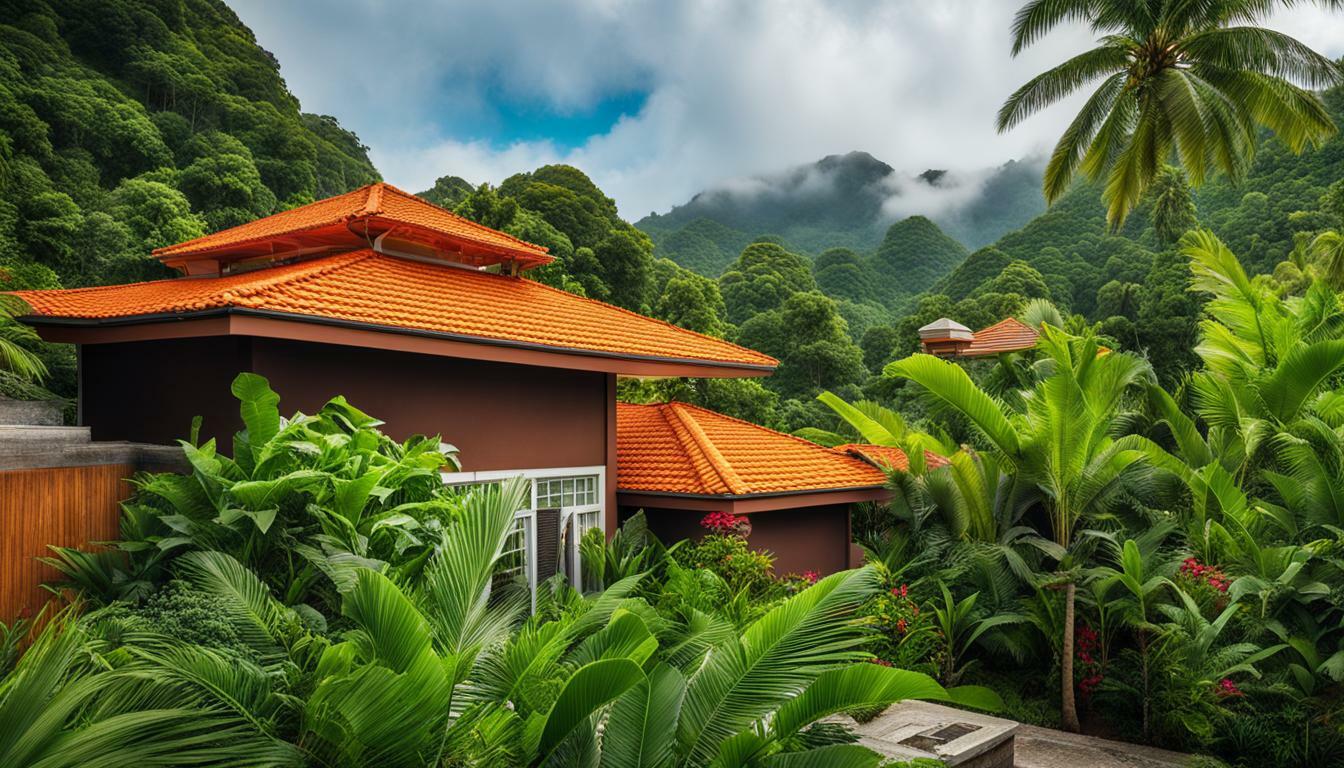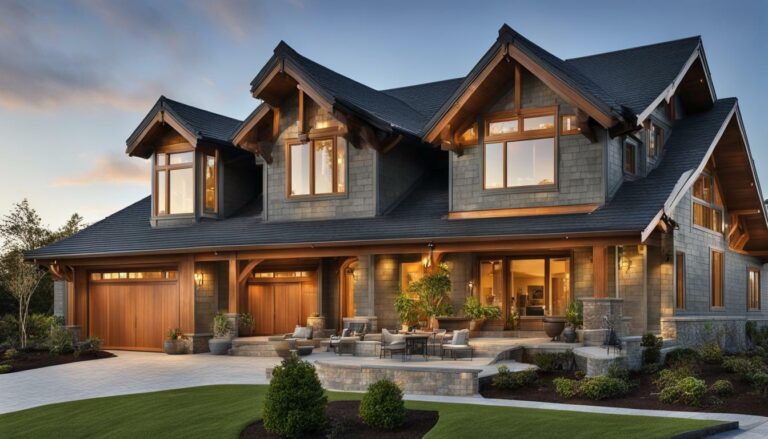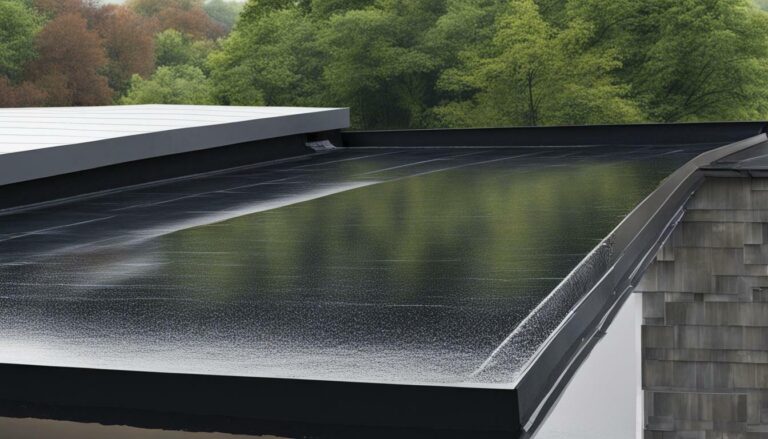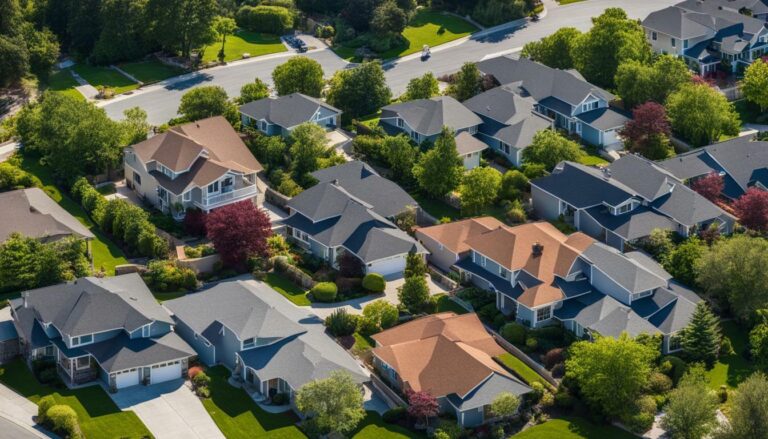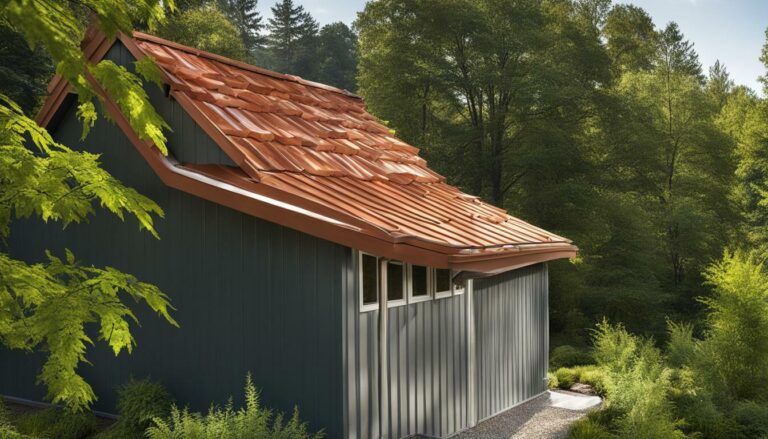Discover the Best Roofs for Tropical Climates – A Guide
When it comes to tropical climates, choosing the right roof is crucial for minimizing heat and protecting against heavy rainfall. The intense heat and frequent rain showers in these regions require roofing materials that can withstand the elements and provide optimal insulation.
As you explore the various roofing options for tropical climates, it’s important to consider factors such as durability, resistance to hurricanes, and heat reflection. Let’s delve into the different types of roofs that are best suited for tropical environments and their respective advantages and disadvantages.
Key Takeaways:
- Flat roofs are ideal for areas with less rainfall and provide a clean, modern aesthetic.
- Pitched roofs are popular in tropical regions due to their ability to effectively drain rainwater.
- Concrete roofs offer excellent resistance to hurricanes, but they can absorb and radiate heat.
- Framed roofs, such as trusses and rafters, provide durability and flexibility in design.
- Metal roofs are known for their durability and heat resistance, making them suitable for tropical climates.
Flat Roofs: Ideal for Less Rainfall
Flat roofs are often favored in tropical regions with less rainfall due to their durability and ability to withstand extreme weather conditions. These roofs are designed with a minimal slope, allowing rainwater to drain efficiently. They are commonly constructed using top roofing materials for hot and humid climates, such as modified bitumen, EPDM (ethylene propylene diene monomer), or PVC (polyvinyl chloride) membranes.
One of the key advantages of flat roofs is their suitability for hot and humid climates. The materials used in their construction are specifically chosen for their ability to resist UV rays and high temperatures, ensuring durability and longevity. Additionally, the flat surface of these roofs provides ample space for the installation of solar panels, making them an energy-efficient choice.
It is important to note that proper insulation and regular maintenance are essential for flat roofs in tropical climates. Adequate insulation helps to regulate the temperature inside the building, reducing cooling costs. Regular inspections and repairs can prevent water leakage, which can cause damage to both the roof and the interior of the building.
Table: Pros and Cons of Flat Roofs for Tropical Climates
| Pros | Cons |
|---|---|
| High durability | Requires regular maintenance |
| Resistant to extreme weather conditions | Requires proper insulation |
| Ample space for solar panel installation | Potential for water leakage if not maintained |
Flat roofs offer a practical and efficient roofing solution for tropical regions with less rainfall. Their durability, resistance to extreme weather, and compatibility with solar panels make them a popular choice among homeowners and commercial builders alike. However, it is crucial to ensure proper insulation and regular maintenance to maximize their performance and longevity.

Pitched roofs are a popular choice in tropical regions due to their aesthetic appeal and ability to efficiently divert rainwater. The steep slope of these roofs allows rain to quickly run off, preventing water accumulation and potential structural damage. Additionally, pitched roofs offer better ventilation and heat dissipation, which can help regulate indoor temperatures in hot and humid climates.
When it comes to choosing the right material for a pitched roof in tropical regions, several options are available. One commonly used material is concrete tiles, known for their durability and resistance to hurricanes. However, it’s important to note that concrete roofs can absorb and radiate heat, making them less suitable for areas with intense sunlight.
An alternative to concrete tiles is metal roofing. Metal roofs are highly durable, able to withstand high winds and heavy rainfall common in tropical climates. Additionally, metal is a heat-resistant material, helping to keep homes cooler by reflecting sunlight. Metal roofs come in various styles and colors, allowing homeowners to choose a design that matches their aesthetic preferences.
Another option for pitched roofs in tropical regions is terracotta clay tiles. These tiles provide a distinctive appearance and are known for their longevity and resistance to weathering. Terracotta clay tiles also offer excellent heat insulation properties, making them a suitable choice for hot and humid climates. Their natural composition allows for good breathability, reducing the risk of mold and mildew growth.
To summarize, when considering a pitched roof in a tropical climate, it’s important to prioritize materials that offer durability, resistance to extreme weather conditions, and effective heat dissipation. Concrete tiles, metal roofing, and terracotta clay tiles are all viable options, each with its own set of advantages. Consulting with a roofing professional can help homeowners make an informed decision based on their specific needs and preferences.
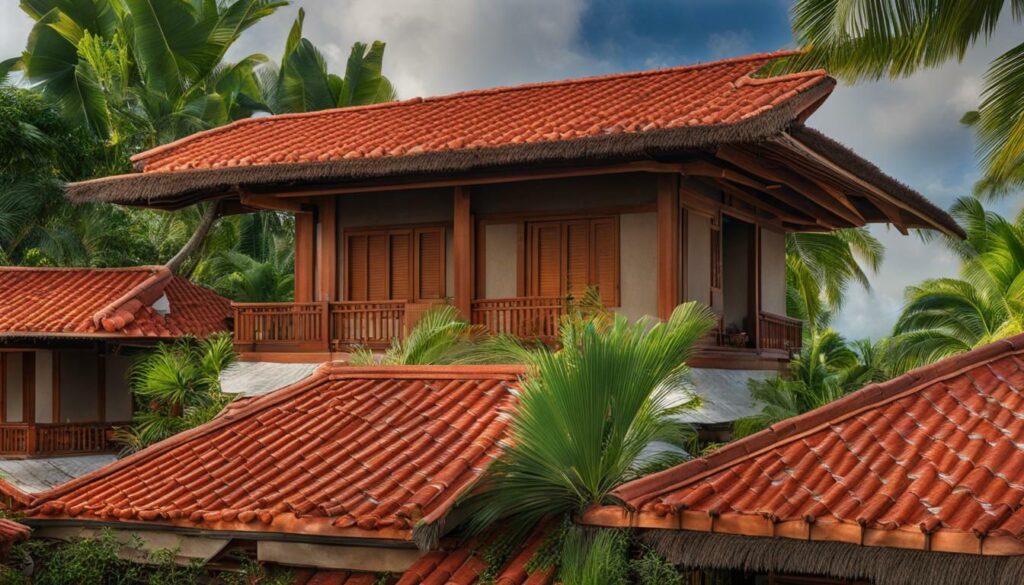
Concrete roofs are known for their resilience against hurricanes, but their heat absorption and radiation make them less ideal for hot and humid tropical climates. While concrete roofs can withstand strong winds and provide excellent protection during storms, they have a tendency to absorb heat from the sun, creating a hotter environment underneath. This can lead to increased cooling costs and discomfort in tropical climates where heat and humidity are already high.
One alternative to mitigate the heat absorption of concrete roofs is to use light-colored or reflective coatings on the surface. These coatings help to reflect sunlight and reduce the amount of heat that is absorbed by the roof. Additionally, insulation materials can be installed beneath the concrete to provide a barrier against heat transfer, helping to keep the interior cooler.
Another consideration with concrete roofs in tropical climates is the weight. Concrete is a heavy material, and the added weight of a concrete roof can put strain on the structure of the building. It is important to ensure that the building’s foundation and structure are capable of supporting the weight of a concrete roof before installation.
“While concrete roofs offer excellent protection against hurricanes, their heat absorption and weight can be drawbacks in hot and humid tropical climates.”
Concrete Roofing Options
There are different types of concrete roofing options available for tropical climates. One popular choice is reinforced concrete, which consists of steel bars embedded within the concrete to provide additional strength and durability. Another option is precast concrete panels, which are manufactured off-site and then assembled on the roof. These panels offer ease of installation and can be customized to fit the desired roof design.
It is important to engage the services of a professional contractor who specializes in concrete roofing to ensure proper installation and maintenance. They can assess the specific requirements of the tropical climate and recommend the most suitable concrete roofing option for the building.
| Advantages of Concrete Roofs | Disadvantages of Concrete Roofs |
|
|
|---|
Choosing the right roofing material for a tropical climate involves considering various factors such as durability, heat resistance, and weight. While concrete roofs offer good hurricane protection, their heat absorption and weight can pose challenges in hot, humid regions. It is essential to explore alternative roofing options that provide better insulation and lower heat retention to maintain a comfortable living environment in tropical climates.
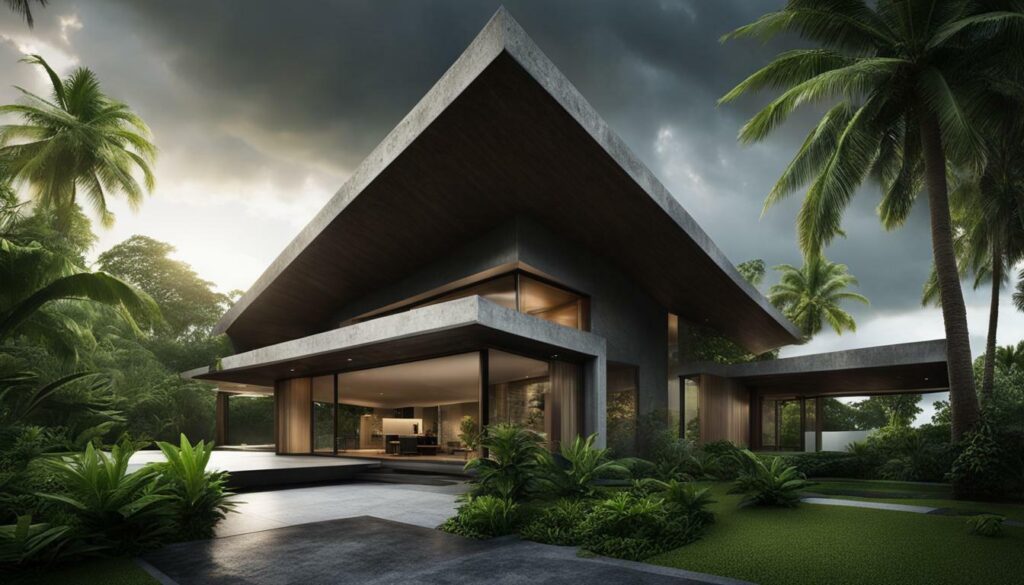
Framed roofs, including trusses and rafters, provide homeowners in tropical climates with a durable and flexible roofing solution. These roof structures are designed to withstand the unique challenges of hot and humid weather, making them an ideal choice for areas prone to high temperatures and heavy rainfall.
One of the key advantages of framed roofs is their ability to distribute weight evenly, ensuring the structural integrity of the building. This is especially important in tropical regions where sudden downpours and strong winds are common. The sturdy framework of trusses and rafters offers superior support, reducing the risk of roof damage or collapse.
Another benefit of framed roofs is their flexibility in design. Homeowners can choose from various roof pitches and shapes to suit their preferences and architectural style. Whether it’s a gable, hip, or combination roof, framed structures can be customized to meet aesthetic and functional requirements. Moreover, framed roofs allow for the integration of additional features such as skylights, solar panels, or rooftop gardens, enhancing the overall value and sustainability of the property.
Enhancing Durability with Quality Materials
When it comes to roofing materials for framed roofs in tropical climates, durability is of utmost importance. Opting for materials that are resistant to heat, moisture, and pests is crucial for long-lasting performance. Here are some popular choices:
| Roofing Material | Advantages |
|---|---|
| Metal | Durable, heat-resistant, and low-maintenance. |
| Clay Tiles | Distinctive appearance, longevity, and natural cooling properties. |
| Slate | Highly durable, fire-resistant, and elegant. |
| Concrete Tiles | Resistant to hurricanes and strong winds. |
Choosing the right roofing material depends on factors such as budget, aesthetic preferences, and local building codes. It’s essential to consult with roofing professionals to ensure the selection aligns with the specific requirements of the tropical climate and offers optimal protection against the elements.
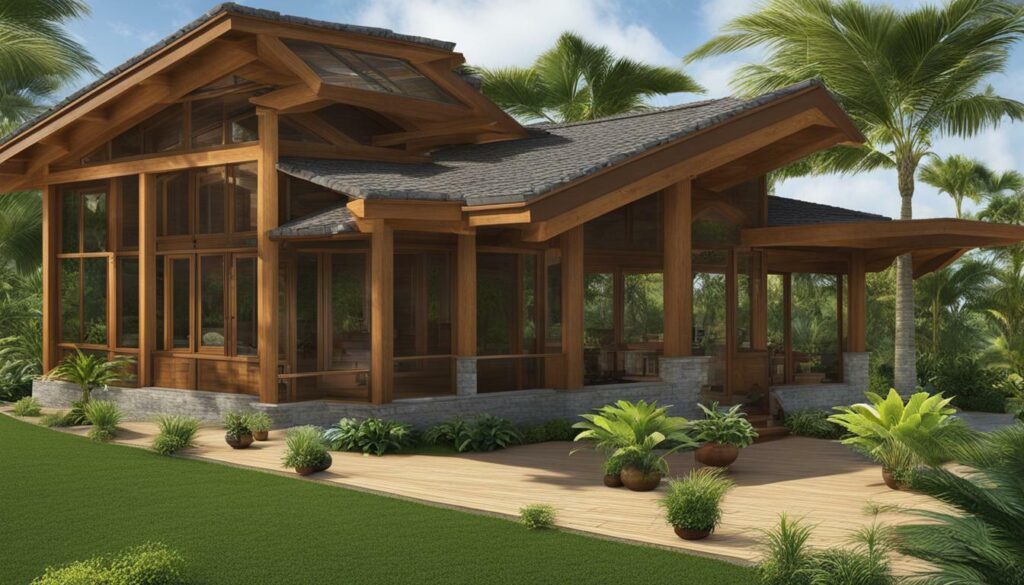
Overall, framed roofs provide homeowners in tropical regions with a durable and flexible roofing solution to withstand the challenges of hot and humid climates. With the right materials and proper installation, these roofs offer both functional and aesthetic benefits, making them a popular choice for tropical homes.
Metal Roofs: Durable and Heat-Resistant
Metal roofs are an excellent choice for tropical climates because of their durability, heat-resistance, and energy efficiency. These roofs are designed to withstand the harsh conditions of hot and humid environments, making them a reliable option for homeowners in tropical regions.
One of the key advantages of metal roofs is their durability. They are resistant to cracking, warping, and corrosion, ensuring that they can withstand the tropical climate’s challenges. Whether it’s strong winds, heavy rain, or intense sunshine, metal roofs can maintain their structural integrity and protect your home for years to come.
In addition to their durability, metal roofs are also heat-resistant. They reflect the sun’s rays, preventing excessive heat absorption into your home. This not only helps keep your living spaces cooler but also reduces the strain on your air conditioning system, resulting in energy savings and lower utility bills.
Furthermore, metal roofs can be an energy-efficient choice for hot and humid climates. With their reflective properties, they minimize heat transfer into your home, reducing the need for excessive cooling. By keeping your indoor spaces cooler, metal roofs contribute to a more comfortable living environment while reducing your carbon footprint.
To summarize, metal roofs offer a range of benefits for tropical regions. They are durable, heat-resistant, and energy-efficient, making them an ideal roofing solution. Consider investing in a metal roof to protect your home from the challenges of the tropical climate while enjoying the long-lasting and cost-effective advantages they provide.
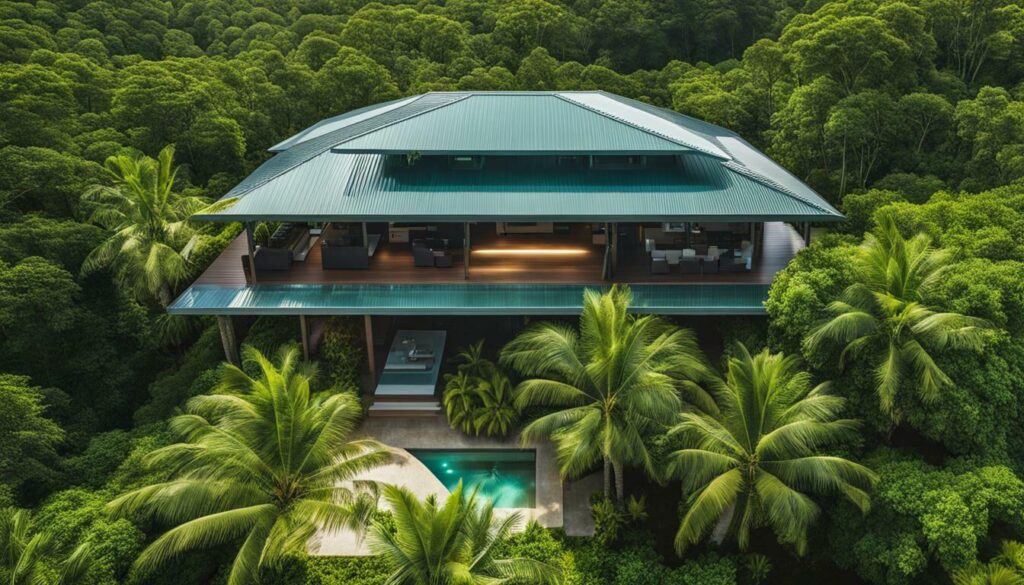
Terracotta Clay Tiles: A Distinctive Option
Terracotta clay tiles provide a distinct appearance and offer excellent durability in tropical climates, making them a popular roofing choice. These tiles, made from natural clay, are known for their ability to withstand extreme weather conditions, ensuring your roof stays intact and protected for years to come.
One of the key benefits of terracotta clay tiles is their ability to regulate temperature. In tropical climates, where temperatures can soar, these tiles help keep your home cool by reflecting sunlight and reducing heat absorption. This can significantly lower energy costs, as you won’t have to rely as heavily on air conditioning to maintain a comfortable indoor environment.
In addition to their practical advantages, terracotta clay tiles also add a touch of elegance to any home. Their warm, earthy tones complement a variety of architectural styles, from traditional to modern. Whether you’re looking to enhance the overall aesthetic of your property or simply appreciate the timeless beauty of terracotta, these tiles are sure to make a statement.

| Advantages of Terracotta Clay Tiles | Disadvantages of Terracotta Clay Tiles |
|---|---|
|
|
“Terracotta clay tiles provide both functionality and aesthetics, making them an excellent choice for homeowners in tropical regions.” – Roofing Expert
Conclusion
When it comes to sustainable roofing choices for tropical regions, terracotta clay tiles stand out as a distinctive and reliable option. Their durability, temperature-regulating properties, and timeless beauty make them well-suited for homes in hot and humid climates. While they may require a slightly higher upfront investment, the long-term benefits outweigh the initial cost. By choosing terracotta clay tiles for your tropical roof, you can enjoy lasting protection and enhance the curb appeal of your property.
Other Roofing Options: Shingles, Solar Shingles, and Natural Materials
In addition to traditional roofing options, there are alternative choices like shingles, solar shingles, and natural materials that can enhance the performance of roofs in tropical climates. Shingles are a popular choice due to their versatility and affordability. They come in various materials such as asphalt, wood, and composite, allowing homeowners to choose the best option for their needs.
Solar shingles, on the other hand, are a sustainable and energy-efficient solution. These innovative roofing materials not only provide protection from the elements but also harness the power of the sun to generate electricity. By integrating solar technology into the roof, homeowners can reduce their reliance on traditional energy sources and lower their utility bills.
For those seeking a more natural and eco-friendly option, materials like thatch and grass can be used. Thatch roofs have been used for centuries in tropical regions due to their excellent insulation and natural beauty. Grass roofs, commonly seen in traditional architecture, offer a unique aesthetic while also providing insulation and environmental benefits.
Comparison Table: Roofing Materials for Tropical Climates
| Roofing Material | Advantages |
|---|---|
| Shingles |
|
| Solar Shingles |
|
| Natural Materials (Thatch and Grass) |
|
When considering alternative roofing options for tropical areas, it’s important to weigh the pros and cons of each material. Factors such as durability, maintenance requirements, and local building codes should be taken into account. Consulting with a professional roofing contractor can help homeowners make an informed decision based on their specific needs and budget.
Remember, choosing the right roof for a tropical climate is crucial for maximizing comfort and protection against the elements. Whether opting for traditional or alternative materials, a well-designed and properly installed roof can withstand the challenges of hot, humid climates and ensure long-lasting performance.
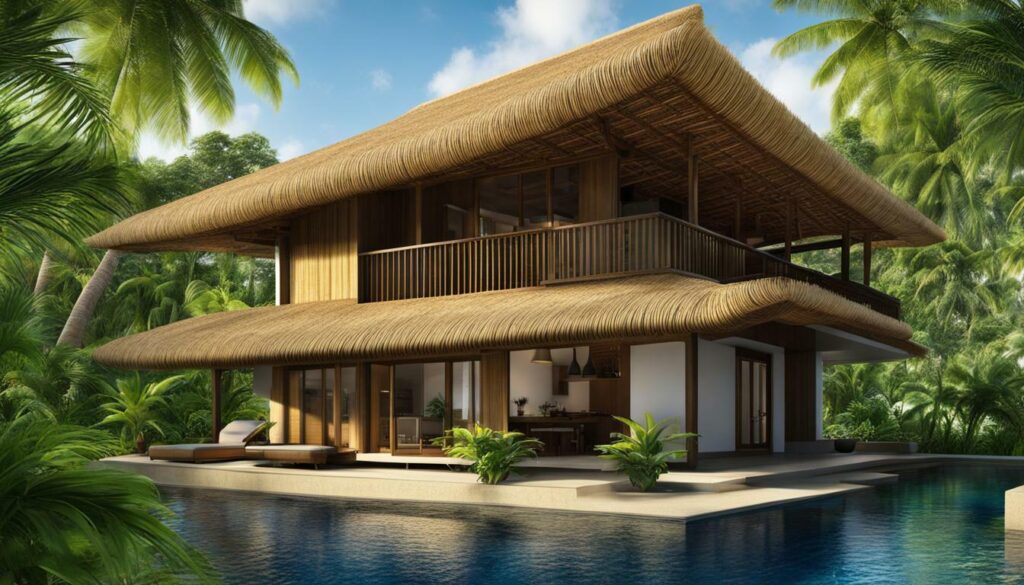
Besides choosing the right material, it’s essential to consider factors like cost, weight, and energy efficiency when selecting the best roof for your tropical climate. These considerations can greatly impact the long-term performance and sustainability of your roofing system.
Cost is an important factor to consider, as it directly affects your budget. While some roofing materials may have a higher upfront cost, they may offer better longevity and require less maintenance, ultimately saving you money in the long run. It’s important to weigh the initial investment against the potential cost of repairs or replacements in the future.
Another factor to consider is the weight of the roofing material. In tropical climates, where heavy rainfall and strong winds are common, it’s crucial to choose a roof that can withstand these conditions without putting excessive strain on the structure of your home. Lightweight materials, such as metal or certain types of shingles, can provide a durable and reliable solution while minimizing the load on your building.
Energy efficiency is also an important consideration, especially in hot and humid climates. A roof with good insulation properties and the ability to reflect or dissipate heat can help reduce the energy consumption of your home and make it more comfortable year-round. Look for energy-efficient roofing options that are designed to minimize heat transfer and keep your interior cool, helping to lower your energy bills.
| Factors to Consider | Considerations |
|---|---|
| Cost | Weigh the upfront cost against long-term savings and potential repairs. |
| Weight | Choose a lightweight material that can withstand heavy rainfall and winds. |
| Energy Efficiency | Select a roof with good insulation and heat-reflective properties. |
By taking into account factors such as cost, weight, and energy efficiency, you can ensure that you make the best choice for your tropical climate. Consult with a professional roofing contractor to guide you through the decision-making process and help you select the roofing option that meets your specific needs and preferences.
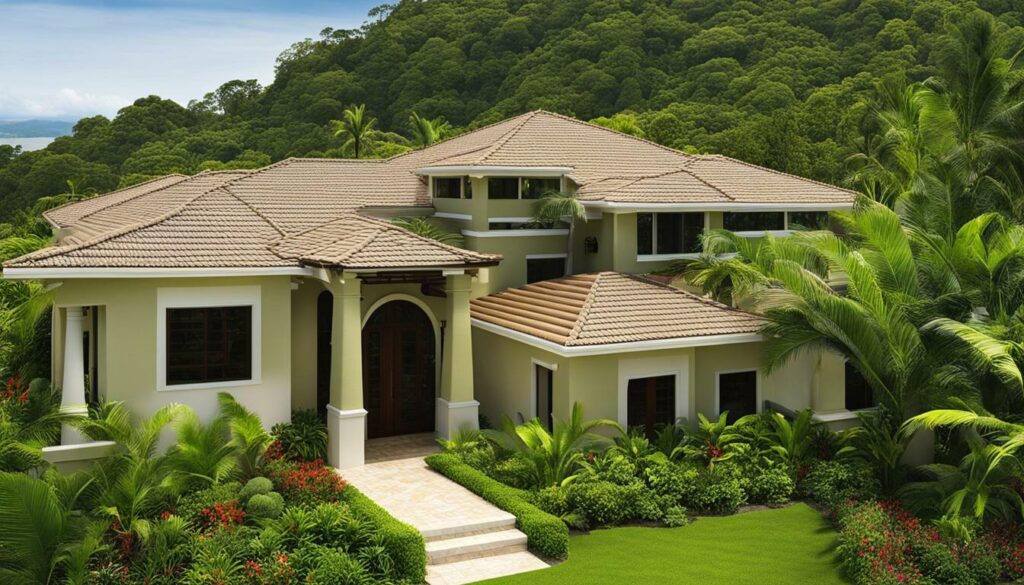
“When it comes to choosing a roof for a tropical climate, one of the most important factors to consider is energy efficiency. A well-insulated roof with proper ventilation can significantly reduce cooling costs and create a more comfortable indoor environment.”
Conclusion
Choosing the best roofs for tropical climates is crucial to ensure durability, energy efficiency, and optimal comfort in your home. In hot and humid regions, flat roofs are ideal, as they are designed to handle less rainfall and prevent water buildup. However, in tropical areas where rainfall is more common, pitched roofs are popular due to their ability to efficiently drain water and withstand heavy downpours.
When it comes to roof materials, concrete roofs offer excellent resistance to hurricanes, making them a reliable option in tropical regions prone to severe weather. However, it’s important to note that concrete roofs can absorb and radiate heat, which may not be ideal for hot and humid climates where insulation and temperature control are crucial.
For those seeking versatility, framed roofs, such as trusses and rafters, provide durability and flexibility in roof design. They can be customized to suit various architectural styles and are known for their strength and stability.
In terms of roofing materials, metal roofs are a popular choice due to their durability and heat-resistant properties. They can withstand harsh weather conditions, including intense sunlight, and provide long-lasting protection for your home. For a distinctive and aesthetically pleasing look, terracotta clay tiles are an excellent option. These tiles not only offer durability but also add a touch of elegance to any tropical home.
There are also alternative roofing materials available, such as roof shingles, solar shingles, and natural materials like thatch and grass. These options provide unique advantages, ranging from energy efficiency to sustainability.
When selecting the best roof for your tropical climate, it’s important to consider additional factors such as cost, weight, and energy efficiency. High-performance roofing solutions that offer both durability and cost-effectiveness are key to ensuring your home is well-protected and comfortable.
By taking into account the specific needs and climate conditions of your tropical region, you can make an informed decision and choose the best roof for your home that will withstand the demands of the environment and provide long-term benefits.
FAQ
Q: What type of roof is best for a tropical climate?
A: In a tropical climate, flat roofs are more suitable for areas with less rainfall, while pitched roofs are popular in regions with heavy rainfall.
Q: Are concrete roofs a good option for tropical climates?
A: While concrete roofs are resistant to hurricanes, they can absorb and radiate heat, making them less ideal for hot and humid climates.
Q: What are some durable roof options for tropical weather?
A: Framed roofs, such as trusses and rafters, offer durability and flexibility in roof design for tropical climates.
Q: What are the benefits of using metal roofs in tropical regions?
A: Metal roofs are durable, heat-resistant, and energy-efficient, making them a great choice for hot and humid tropical climates.
Q: What are terracotta clay tiles and why are they a distinctive option?
A: Terracotta clay tiles provide a distinct appearance and are a sustainable roofing choice for tropical regions.
Q: What are some other roofing options for tropical climates?
A: Other options include roof shingles, solar shingles for energy efficiency, and natural materials like thatch and grass.
Q: What additional considerations should I keep in mind when choosing a roof for a tropical climate?
A: Additional considerations include cost, weight, and energy efficiency to ensure a high-performance and cost-effective roof for tropical conditions.
